Autonomous Driving Algorithm Research: BEV Drives Algorithm Revolution, AI Large Model Promotes Algorithm Iteration
The core of the autonomous driving algorithm technical framework is divided into three parts: environment perception, decision planning, and control execution.
Environment perception: convert sensor data into machine language of the scenario where the vehicle is located, which can include object detection, recognition and tracking, environment modeling, motion estimation, etc.;
Decision planning: Based on the output results of perception algorithm, the final behavioral action instructions are given, including behavioral decisions (vehicle following, stopping and overtaking), action decisions (car steering, speed, etc.), path planning, etc.;
Control actuation: according to the output results of decision-making level, the underlying modules are mobilized to issue instructions to the core control components such as accelerator and brake, and promote vehicle to drive according to the planned route.
BEV drives algorithm revolution
In recent years, BEV perception has received extensive attention. BEV model mainly provides a unified space to facilitate the fusion of various tasks and sensors. It has following advantages:
BEV unifies the multimodal data processing dimension and makes multimodal fusion easier
The BEV perception system converts the information obtained from multiple cameras or radars to a bird's-eye view, and then do tasks such as object detection and instance segmentation, which can more intuitively display the dimension and direction of objects in BEV space.
In 2022, Peking University & Ali proposed a fusion framework of LiDAR and vision - BEVFusion. The processing of radar point clouds and image processing are carried out independently, using neural networks to encode, project to a unified BEV space, and then merge the two in BEV space.
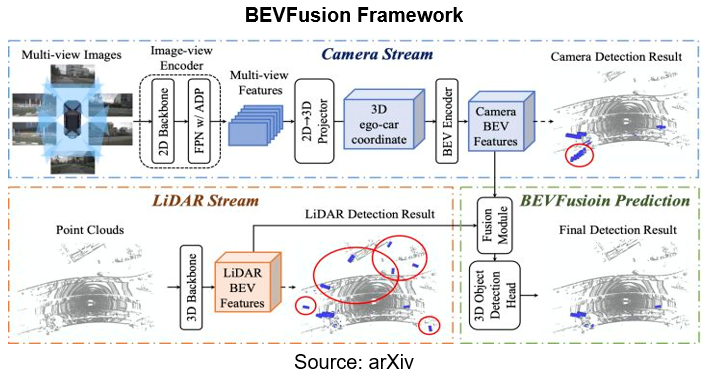
Realize timing information fusion and build 4D space
In the 4D space, the perception algorithm can better complete the perception tasks such as speed measurement, and can transmit the results of motion prediction to the decision and control module.
PhiGent Robotics proposed BEVDet4D in 2022, which is a version based on BEVDet to increase timing fusion. BEVDet4D extends BEVDet by retaining intermediate BEV features of past frames, and then fuses features by aligning and splicing with the current frame, so that time clues can be obtained by querying two candidate features.
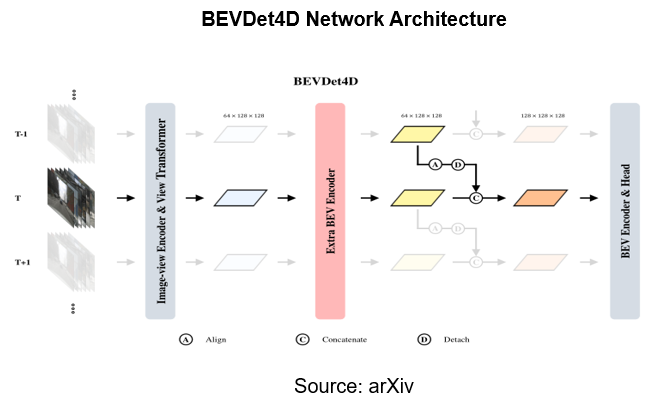
Imagine occluded objects to realize object prediction
In the BEV space, the algorithm can predict the occluded area based on prior knowledge, and imagine whether there are objects in the occluded area.
FIERY, proposed by Wayve in cooperation with the University of Cambridge in 2021, is an end-to-end road dynamic object instance prediction algorithm that does not rely on high-precision maps and is only based on aerial views of monocular cameras.
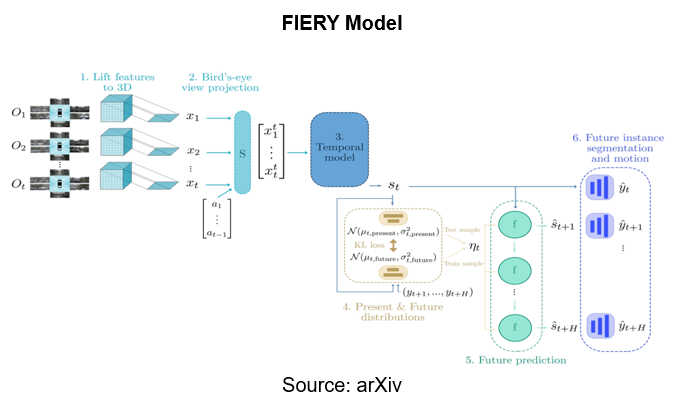
Promoting development of an end-to-end autonomous driving framework
In the BEV space, perception and prediction can be directly optimized end-to-end through neural networks in a unified space, and the results can be obtained at the same time. Not only the perception module, but also the BEV-based planning decision-making module is also the direction of academic research.
In 2022, autonomous driving team of Shanghai Artificial Intelligence Laboratory and the team of associate professor Yan Junchi of Shanghai Jiao Tong University collaborated on paper ST-P3 to propose a spatiotemporal feature learning solution that can simultaneously provide a set of more representative features for perception, prediction and planning tasks.
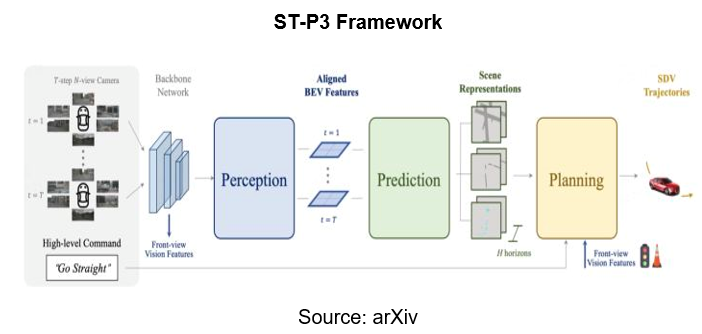
AI large model drives algorithm iteration
After 2012, deep learning algorithms are widely applied in autonomous driving field. In order to support larger and more complex AI computing needs, AI large models with the characteristics of "huge data, huge computing power, and huge algorithms" were born, which accelerated the iteration speed of algorithms.
Large Model and Intelligent Computing Center
In 2021, HAOMO.AI launched research and landing attempts on large-scale Transformer model, and then gradually applied it on a large scale in projects including multi-modal perception data fusion and cognitive model training. In December 2021, HAOMO.AI released autonomous driving data intelligence system MANA (Chinese name "Snow Lake"), which integrates perception, cognition, labeling, simulation, computing and other aspects. In January 2023, HAOMO.AI together with Volcano Engine unveiled MANA OASIS, a supercomputing center with a total computing power of 670 PFLOPS. After deploying HAOMO.AI's training platform, OASIS can run various applications including cloud large-scale model training, vehicle-side model training, annotation, and simulation. With the help of MANA OASIS, the five major models of HAOMO.AI have ushered in a new appearance and upgrade.
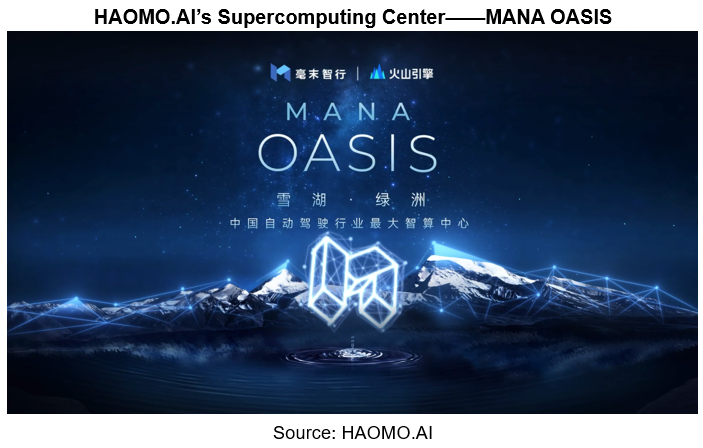
In August 2022, based on Alibaba Cloud intelligent computing platform, Xpeng Motors built an autonomous driving intelligent computing center "Fuyao", which is dedicated to training of autonomous driving models. In October 2022, Xpeng also announced the introduction of Transformer large model.
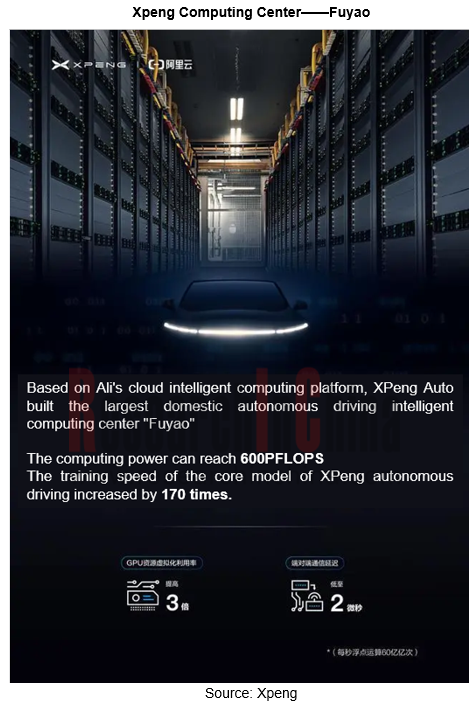
In November 2022, Baidu released Wenxin Big Model. Leveraging more than 1 billion parameters, it recognizes thousands of objects, helping to enlarge the scope of semantic recognition. At present, it is mainly used in three aspects: distance vision, multimodality and data mining.

OEMs and Tier 1 Suppliers' Cost Reduction and Efficiency Enhancement Strategy Analysis Report, 2025
ResearchInChina released the "OEMs and Tier 1 Suppliers' Cost Reduction and Efficiency Enhancement Strategy Analysis Report, 2025", summarizing hundreds of cost reduction strategies to provide referen...
Automotive Fixed Panoramic Sunroof and Smart Roof Research Report, 2025
With the intelligent application of car roofs as the core, this report systematically sorts out a series of new products such as fixed panoramic sunroof/openable sunroof, ceiling screen, roof ambient ...
Automotive-Grade Power Semiconductor and Module (SiC, GaN) Industry Research Report, 2025
SiC/GaN Research: Sales volume of 800V+ architecture-based vehicles will increase more than 10 times, and hybrid carbon (SiC+IGBT) power modules are rapidly being deployed in vehicles.
Sales volume o...
Cockpit Agent Engineering Research Report, 2025
Cockpit Agent Engineering Research: Breakthrough from Digital AI to Physical AI
Cockpit Agent Engineering Research Report, 2025 starts with the status quo of cockpit agents, summarizes the technical ...
Prospective Study on L3 Intelligent Driving Technology of OEMs and Tier 1 Suppliers, 2025
L3 Research: The Window of Opportunity Has Arrived - Eight Trends in L3 Layout of OEMs and Tier 1 Suppliers
Through in-depth research on 15 OEMs (including 8 Chinese and 7 foreign OEMs) and 9 Tier 1 ...
China Commercial Vehicle IoV and Intelligent Cockpit Industry Research Report 2025
Commercial Vehicle IoV and Cockpit Research: The Third Wave of Passenger Car/Commercial Vehicle Technology Integration Arrives, and T-Box Integrates e-Call and 15.6-inch for Vehicles
I. The third wav...
Intelligent Vehicle Electronic and Electrical Architecture (EEA) and Technology Supply Chain Construction Strategy Research Report, 2025
E/E Architecture Research: 24 OEMs Deploy Innovative Products from Platform Architectures to Technical Selling Points
According to statistics from ResearchInChina, 802,000 passenger cars with domain...
Research Report on Intelligent Vehicle Cross-Domain Integration Strategies and Innovative Function Scenarios, 2025
Cross-Domain Integration Strategy Research: Automakers' Competition Extends to Cross-Domain Innovative Function Scenarios such as Cockpit-Driving, Powertrain, and Chassis
Cross-domain integration of ...
China Autonomous Driving Data Closed Loop Research Report, 2025
Data Closed-Loop Research: Synthetic Data Accounts for Over 50%, Full-process Automated Toolchain Gradually Implemented
Key Points:From 2023 to 2025, the proportion of synthetic data increased from 2...
Automotive Glass and Smart Glass Research Report, 2025
Automotive Glass Report: Dimmable Glass Offers Active Mode, Penetration Rate Expected to Reach 10% by 2030
ResearchInChina releases the Automotive Glass and Smart Glass Research Report, 2025. This r...
Passenger Car Brake-by-Wire (BBW) Research Report, 2025
Brake-by-Wire: EHB to Be Installed in 12 Million Vehicles in 2025
1. EHB Have Been Installed in over 10 Million Vehicles, A Figure to Hit 12 Million in 2025.
In 2024, the brake-by-wire, Electro-Hydr...
Autonomous Driving Domain Controller and Central Computing Unit (CCU) Industry Report, 2025
Research on Autonomous Driving Domain Controllers: Monthly Penetration Rate Exceeded 30% for the First Time, and 700T+ Ultrahigh-compute Domain Controller Products Are Rapidly Installed in Vehicles
L...
China Automotive Lighting and Ambient Lighting System Research Report, 2025
Automotive Lighting System Research: In 2025H1, Autonomous Driving System (ADS) Marker Lamps Saw an 11-Fold Year-on-Year Growth and the Installation Rate of Automotive LED Lighting Approached 90...
Ecological Domain and Automotive Hardware Expansion Research Report, 2025
ResearchInChina has released the Ecological Domain and Automotive Hardware Expansion Research Report, 2025, which delves into the application of various automotive extended hardware, supplier ecologic...
Automotive Seating Innovation Technology Trend Research Report, 2025
Automotive Seating Research: With Popularization of Comfort Functions, How to Properly "Stack Functions" for Seating?
This report studies the status quo of seating technologies and functions in aspe...
Research Report on Chinese Suppliers’ Overseas Layout of Intelligent Driving, 2025
Research on Overseas Layout of Intelligent Driving: There Are Multiple Challenges in Overseas Layout, and Light-Asset Cooperation with Foreign Suppliers Emerges as the Optimal Solution at Present
20...
High-Voltage Power Supply in New Energy Vehicle (BMS, BDU, Relay, Integrated Battery Box) Research Report, 2025
The high-voltage power supply system is a core component of new energy vehicles. The battery pack serves as the central energy source, with the capacity of power battery affecting the vehicle's range,...
Automotive Radio Frequency System-on-Chip (RF SoC) and Module Research Report, 2025
Automotive RF SoC Research: The Pace of Introducing "Nerve Endings" such as UWB, NTN Satellite Communication, NearLink, and WIFI into Intelligent Vehicles Quickens
RF SoC (Radio Frequency Syst...